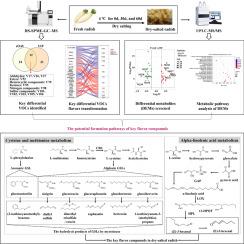Integrated analysis of volatilomics and metabolomics reveals the flavor generation in dry-salted radish (Raphanus sativus L.)
IF 8
1区 农林科学
Q1 FOOD SCIENCE & TECHNOLOGY
引用次数: 0
Abstract
Dry-salted radish holds considerable significance owing to its distinctive flavor characteristics. However, the overall profile and formation pathways of the volatile organic compounds (VOCs) remain elusive. This study employed GC–MS-based volatilomics and UPLC-MS/MS-based metabolomics, coupled with multivariate statistical methods such as PCA, PLS-DA, and OPLS-DA to elucidate the dynamic evolution of 120 VOCs and 242 flavor precursor metabolites in both fresh and dry-salted radish over a 60-day salting period. The results demonstrated that variations in the relative content of 12 key differential VOCs, such as erucin and 2-hexenal, play a decisive role in improving the flavor of dry-salted radish, particularly in reducing sulfury, garlic, and cooked onion notes while increasing fruity and sweet flavors. Furthermore, 110 differentially expressed metabolites (DEMs) exert a crucial influence on the flavor property of dry-salted radish, primarily through alpha-linolenic acid metabolism and amino acid-related metabolic pathways involving cysteine and methionine metabolism. Our findings provide valuable guidance for the flavor regulation of dry-salted radish.

挥发性和代谢组学综合分析揭示了干腌萝卜(Raphanus sativus L.)风味的产生。
干腌萝卜因其独特的风味特点而具有相当重要的意义。然而,挥发性有机化合物(VOCs)的总体特征和形成途径仍然难以捉摸。本研究采用GC-MS-based挥发物学和UPLC-MS/MS-based代谢组学,结合PCA、PLS-DA和OPLS-DA等多元统计方法,研究了新鲜和干盐萝卜在60天腌制过程中120种挥发性有机化合物和242种风味前体代谢物的动态演变。结果表明,芥子素和2-己烯醛等12种关键差异挥发性有机化合物的相对含量变化对改善干腌萝卜的风味起着决定性作用,特别是在减少硫、大蒜和熟洋葱的味道,同时增加果味和甜味方面。此外,110种差异表达代谢物(DEMs)主要通过α -亚麻酸代谢和氨基酸相关代谢途径,包括半胱氨酸和蛋氨酸代谢,对咸干萝卜的风味特性产生至关重要的影响。研究结果对咸干萝卜的风味调控具有一定的指导意义。
本文章由计算机程序翻译,如有差异,请以英文原文为准。
求助全文
约1分钟内获得全文
求助全文
来源期刊

Food Research International
工程技术-食品科技
CiteScore
12.50
自引率
7.40%
发文量
1183
审稿时长
79 days
期刊介绍:
Food Research International serves as a rapid dissemination platform for significant and impactful research in food science, technology, engineering, and nutrition. The journal focuses on publishing novel, high-quality, and high-impact review papers, original research papers, and letters to the editors across various disciplines in the science and technology of food. Additionally, it follows a policy of publishing special issues on topical and emergent subjects in food research or related areas. Selected, peer-reviewed papers from scientific meetings, workshops, and conferences on the science, technology, and engineering of foods are also featured in special issues.
 求助内容:
求助内容: 应助结果提醒方式:
应助结果提醒方式:


